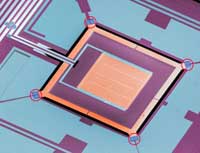Apr 16 2008
Researchers at the National Institute of Standards and Technology (NIST) have combined two tiny but powerful NIST inventions on a single microchip, a cryogenic sensor and a microrefrigerator. The combination offers the possibility of cheaper, simpler and faster precision analysis of materials such as semiconductors and stardust.
 Colorized micrograph of a NIST chip combining four microrefrigerators (circled in red) with a superconducting sensor (large orange square in the middle). The self-cooling chip could be used for applications ranging from detailed X-ray analysis of semiconductors to detection of microwave signals in deep space. Credit: Credit: N. Miller, K. Talbott NIST
Colorized micrograph of a NIST chip combining four microrefrigerators (circled in red) with a superconducting sensor (large orange square in the middle). The self-cooling chip could be used for applications ranging from detailed X-ray analysis of semiconductors to detection of microwave signals in deep space. Credit: Credit: N. Miller, K. Talbott NIST
As described in an upcoming issue of Applied Physics Letters, the NIST team combined a transition-edge sensor (TES), a superconducting thin film that identifies X-ray signatures far more precisely than any other device, with a solid-state refrigerator based on a sandwich of a normal metal, an insulator and a superconductor. The combo chip, a square about a quarter inch on a side, achieved the first cooling of a fully functional detector (or any useful device) with a microrefrigerator. The paper also reports the greatest temperature reduction in a separate object by microrefrigerators: a temperature drop of 110 millikelvins (mK), or about a tenth of a degree Celsius.
TES sensors are most sensitive at about 100 mK (a tenth of a degree Celsius above absolute zero). However, these ultralow temperatures are usually reached only by bulky, complex refrigerators. Because the NIST chip can provide some of its own cooling, it can be combined easily with a much simpler refrigerator that starts at room temperature and cools down to about 300 mK, says lead scientist Joel Ullom. In this setup, the chip would provide the second stage of cooling from 300mK down to the operating temperature (100 mK).
One promising application is cheaper, simpler semiconductor defect analysis using X-rays. A small company is already commercializing an earlier version of TES technology for this purpose. In another application, astronomical telescopes are increasingly using TES arrays to take pictures of the early universe at millimeter wavelengths. Use of the NIST chips would lower the temperature and increase the speed at which these images could be made, Ullom says.